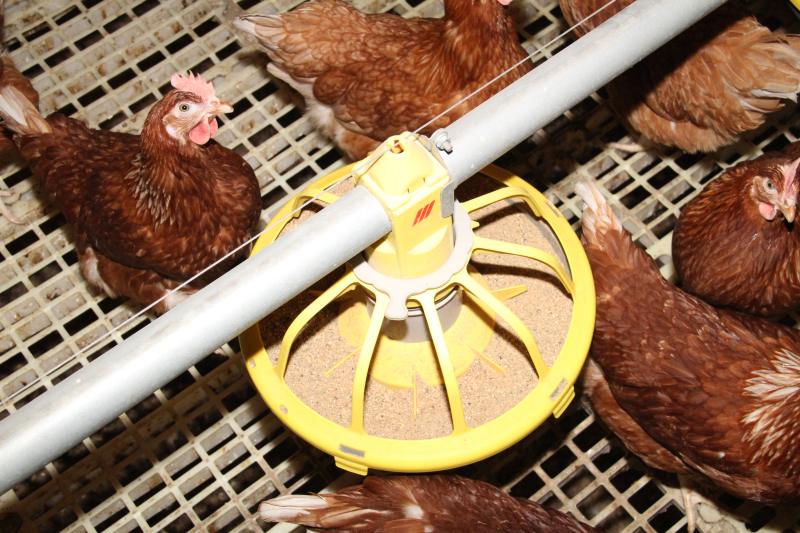
A huge increase in the cost of vitamins and synthetic pigments will add to poultry feed costs over the coming months, according to manufacturers.
Reasons for the increase include China significantly scaling back its production of vitamins A and E in an effort to reduce factory emissions, and a large fire at the BASF plant in Ludwigshafen, Germany.
This plant is one of the world’s primary suppliers of vitamins and colourants and it is not expected to be up and running again until April at the earliest, putting unprecedented demand on the rest of the world’s supply.
Both Martin Humphrey of Humphrey Feeds and Russell Crang of Crediton Milling have warned FarmingUK of spiralling vitamin costs.
"The cost of vitamin A has risen from €20 a kilo to €350 a kilo," said Martin Humphrey. Although a small part of feed ingredients, the size of the increase is likely to add to feed costs for some time.
"The availability and cost of vitamins and synthetic pigments are likely to have the greatest impact on prices in the short term as we enter the New Year," said Mr Crang.
He said at this moment in time, the BASF plant fire is set to have a greater short term impact on price than wheat and soya put together.
'Unexpected events'
Martin Humphrey said the German factory produced 50 per cent of vitamins A and E on the market.
It was also the only supplier of red pigment that was approved for use under the British Egg Industry Council's Lion code, he said.
"I think it will be the third quarter of the year before we see sensible prices again."
Russell Crang said unexpected events had made it very difficult to predict markets: "If we think dealing with animal nutrition is hard enough, trying to digest all the information that has affected the raw material markets over that last 12 months has been pretty much an impossible task."
Aside from the completely unexpected hike in vitamin costs, there have been far more public shocks to the wider system - the unexpected vote for the UK to leave the European Union in June 2016 and the election of outsider Donald Trump to the US presidency the following November.
"We are all well aware that we are involved in global markets and the effect this has on pricing, but we sometimes underestimate the local impact, even more so when something pretty major happens that massively effects the European economy and currencies," said Mr Crang.
Value of Sterling
The shock Brexit result was followed by huge falls in the value of Sterling against both the Dollar and the Euro.
The Pound has shown some recovery over recent months and Russell Crang said that this, together with good supplies, had helped to keep down the price of soya.
"World soya bean supply is looking ok with carry out stocks continuing to increase each year, with current world stock to use ratio at around 22 per cent, which is just under three months supply."
The benefit of larger stocks and improved currency exchange against the Dollar over recent months had left soya year-on-year some £20 per tonne lower in price, he said.
Whilst Sterling has improved somewhat since the initial shock of the Brexit vote, it still remains down on where it was before the referendum and Martin Humphrey believes uncertainty is likely to continue as the UK tries to negotiate a way out of the EU.
"Uncertainty will clearly continue to be a big issue. Sterling will continue to lag and that is unlikely to improve during 2018 and 2019 - until we have a clearer picture of what things are going to look like the pressure will still be on."
Mixed
Russell Crang suggested that the message on wheat was mixed.
He said: "The world supply of wheat has never been better, with a projected buffer stock at the end of this crop year being 268 metric million tonnes (mmt), which is just over three months usage.
"Bearing in mind that back in 2006 the stocks were just over 120 mmt, it has more than doubled, but demand has also increased significantly."
"World supply and demand for wheat looks pretty good, but local supply has become far more of an issue. Although a stronger Pound to the Dollar has meant that soya prices have eased, unfortunately a weaker Pound to the Euro has meant that UK cereals have become very cost effective to export and we have seen a huge increase in export programmes since new crop and this will continue throughout this crop year, making home supply very tight.
"Although wheat futures on the back of world crops have dropped, very tight stocks in the UK has meant the gap between wheat futures and physical wheat prices has increased significantly, and is likely to continue to increase. With wheat being the lion’s share of most poultry diets, the net effect is greater than with soya."
Martin Humphrey pointed to a North South divide on feed wheat prices in the UK. Feed wheat was most expensive in Scotland but also more expensive in the North of England than in the South of England.
"It reflects where the wheat is grown. A lot of the milling wheat is in the North; the feed wheat is in the South."
Transporting the feed wheat North made it more expensive, said Martin.
